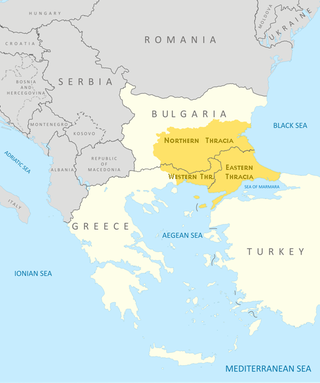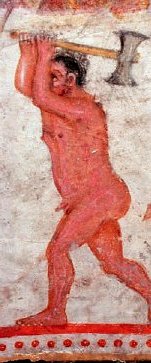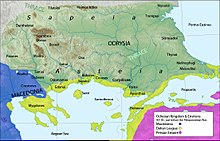
Thrace is a geographical and historical region in Southeast Europe. Bounded by the Balkan Mountains to the north, the Aegean Sea to the south, and the Black Sea to the east, it comprises present-day southeastern Bulgaria, northeastern Greece, and the European part of Turkey, roughly the Roman Province of Thrace. Lands also inhabited by ancient Thracians extended in the north to modern-day Northern Bulgaria and Romania and to the west into Macedonia.

Zalmoxis also known as Salmoxis (Σάλμοξις), Zalmoxes (Ζάλμοξες), Zamolxis (Ζάμολξις), Samolxis (Σάμολξις), Zamolxes (Ζάμολξες), or Zamolxe (Ζάμολξε) is a divinity of the Getae and Dacians, mentioned by Herodotus in his Histories Book IV, 93–96, written before 425 BC.

The Dacians were the ancient Indo-European inhabitants of the cultural region of Dacia, located in the area near the Carpathian Mountains and west of the Black Sea. They are often considered a subgroup of the Thracians. This area includes mainly the present-day countries of Romania and Moldova, as well as parts of Ukraine, Eastern Serbia, Northern Bulgaria, Slovakia, Hungary and Southern Poland. The Dacians and the related Getae spoke the Dacian language, which has a debated relationship with the neighbouring Thracian language and may be a subgroup of it. Dacians were somewhat culturally influenced by the neighbouring Scythians and by the Celtic invaders of the 4th century BC.

The Thracians were an Indo-European speaking people who inhabited large parts of Southeast Europe in ancient history. Thracians resided mainly in Southeast Europe in modern-day Bulgaria, Romania, North Macedonia and northern Greece, but also in north-western Anatolia in Turkey.

The Rhodopes are a mountain range in Southeastern Europe, and the largest by area in Bulgaria, with over 83% of its area in the southern part of the country and the remainder in Greece. Golyam Perelik is its highest peak at 2,191 meters (7,188 ft). The mountain range gives its name to the terrestrial ecoregion Rodope montane mixed forests that belongs in the temperate broadleaf and mixed forests biome and the Palearctic realm. The region is particularly notable for its karst areas with their deep river gorges, large caves and specific sculptured forms, such as the Trigrad Gorge.

The Agathyrsi were an ancient people belonging to the Scythian cultures who lived in the Transylvanian Plateau, in the region that later became Dacia. The Agathyrsi are largely known from Herodotus of Halicarnassus's description of them in the 5th century BC.

In antiquity, Paeonia or Paionia was the land and kingdom of the Paeonians or Paionians.

The Getae or Getai were a large nation who inhabited the regions to either side of the Lower Danube in what is today northern Bulgaria and southern Romania, throughout much of Classical Antiquity. Our main source of information about the Getae are Greek and Roman writers, at least some of whom believed that the Getae were closely related to the neighbouring Thracians to the south, and Dacians to the north. Modern scholars continue to debate the details of these relationships, including the question of whether these three peoples spoke the same language.

The Bessi or Bessae were a Thracian tribe that inhabited the upper valley of the Hebros and the lands between the Haemus and Rhodope mountain ranges in historical Thrace.

The Edoni were a Thracian tribe who dwelt mostly between the Nestus and the Strymon rivers in southern Thrace, but also once dwelt west of the Strymon at least as far as the Axios. They inhabited the region of Mygdonia before the Macedonians drove them out. After that, they settled in the region of Edonis which was named after them. There were a number of Edonian cities in the Classical era, including Drabeskos and Myrkinos.

The Pieres were a Thracian tribe connected with the Brygi, that long before the archaic period in Greece occupied the narrow strip of plain land, or low hill, between the mouths of the Peneius and the Haliacmon rivers, at the foot of the great woody steeps of Mount Olympus. This region was named after them as Pieria.

The Thracian religion comprised the mythology, ritual practices and beliefs of the Thracians, a collection of closely related ancient Indo-European peoples who inhabited eastern and southeastern Europe and northwestern Anatolia throughout antiquity and who included the Thracians proper, the Getae, the Dacians, and the Bithynians.
Miltiades the Elder was an Athenian politician from the Philaid family. He is most famous for travelling to the Thracian Chersonese where, at the behest of the local peoples, he ruled as a tyrant. During his reign, Miltiades' best-attested action was the construction of a defensive wall across the peninsula.
Bistones is the name of a Thracian people who dwelt between Mount Rhodopé and the Aegean Sea, beside Lake Bistonis, near Abdera extending westward as far as the river Nestus. It was through the land of the Bistones that Xerxes marched on his invasion of Greece. The Bistones continued to exist at the time when the Romans were masters of Thrace. Roman poets sometimes use the names of the Bistones for that of the Thracians in general. Pliny mentions one town as belonging to the Bistones: Tirida; the other towns on their coast, Dicaea, Ismaron, Parthenion, Phalesina and Maronea, were Greek colonies.

In Greek mythology, Orpheus was a Thracian bard, legendary musician and prophet. He was also a renowned poet and, according to the legend, travelled with Jason and the Argonauts in search of the Golden Fleece, and even descended into the underworld of Hades, to recover his lost wife Eurydice.

Odomanti or Odomantes were an ancient tribe. Some regard it as Paeonian, while others claim, that the tribe was with certainty Thracian. The Odomanti are noted by Herodotus, Thucydides, Stephanus of Byzantium and Pliny the Elder.

Paiti is the name of a Thracian tribe.

Paeonians were an ancient Indo-European people that dwelt in Paeonia. Paeonia was an old country whose location was to the north of Ancient Macedonia, to the south of Dardania, to the west of Thrace and to the east of Illyria, most of their land was in the Axios river basin, roughly in what is today North Macedonia.














